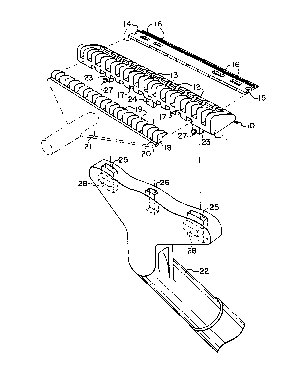Some of the information on this Web page has been provided by external sources. The Government of Canada is not responsible for the accuracy, reliability or currency of the information supplied by external sources. Users wishing to rely upon this information should consult directly with the source of the information. Content provided by external sources is not subject to official languages, privacy and accessibility requirements.
Any discrepancies in the text and image of the Claims and Abstract are due to differing posting times. Text of the Claims and Abstract are posted:
| (12) Patent: | (11) CA 2092532 |
|---|---|
| (54) English Title: | SAFETY RAZORS |
| (54) French Title: | RASOIRS DE SURETE |
| Status: | Expired and beyond the Period of Reversal |
| (51) International Patent Classification (IPC): |
|
|---|---|
| (72) Inventors : |
|
| (73) Owners : |
|
| (71) Applicants : |
|
| (74) Agent: | MACRAE & CO. |
| (74) Associate agent: | |
| (45) Issued: | 1998-12-15 |
| (86) PCT Filing Date: | 1991-10-10 |
| (87) Open to Public Inspection: | 1992-04-23 |
| Examination requested: | 1996-03-14 |
| Availability of licence: | N/A |
| Dedicated to the Public: | N/A |
| (25) Language of filing: | English |
| Patent Cooperation Treaty (PCT): | Yes |
|---|---|
| (86) PCT Filing Number: | PCT/US1991/007468 |
| (87) International Publication Number: | WO 1992006827 |
| (85) National Entry: | 1993-03-25 |
| (30) Application Priority Data: | ||||||
|---|---|---|---|---|---|---|
|
A safety razor having one or more blades (14) seated
between a cap (11) and guard (12), said guard cap and guard
having a comb configuration in which a comb like moulding
(18) of a mixture of polyethylene oxide and a structural
polymer, such as polystyrene is positioned between the teeth (13) of
the comb-like cap portion, the teeth (19) of the polyethylene
oxide-containing moulding being narrower than the space
between the teeth of the cap portion so that the blade unit can
flex concavely.
Rasoir de sûreté comprenant une ou plusieurs lames (14) placées entre un couvercle (11) et un dispositif de protection (12). Ces deux derniers éléments ont la forme d'un peigne dans lequel une moulure en forme de peigne (18) composée d'un mélange de poly(éthylène oxyde) et de polymère de structure, comme du polystyrène, est placée entre les dents (13) du couvercle en forme de peigne. Les dents (19) de la moulure contenant du poly(éthylène oxyde) sont moins espacées que celles du couvercle, ce qui permet à la lame de fléchir de façon concave.
Note: Claims are shown in the official language in which they were submitted.
Note: Descriptions are shown in the official language in which they were submitted.

2024-08-01:As part of the Next Generation Patents (NGP) transition, the Canadian Patents Database (CPD) now contains a more detailed Event History, which replicates the Event Log of our new back-office solution.
Please note that "Inactive:" events refers to events no longer in use in our new back-office solution.
For a clearer understanding of the status of the application/patent presented on this page, the site Disclaimer , as well as the definitions for Patent , Event History , Maintenance Fee and Payment History should be consulted.
| Description | Date |
|---|---|
| Time Limit for Reversal Expired | 2010-10-12 |
| Letter Sent | 2009-10-13 |
| Inactive: IPC from MCD | 2006-03-11 |
| Inactive: IPC from MCD | 2006-03-11 |
| Grant by Issuance | 1998-12-15 |
| Pre-grant | 1998-07-28 |
| Inactive: Final fee received | 1998-07-28 |
| Notice of Allowance is Issued | 1998-02-23 |
| Notice of Allowance is Issued | 1998-02-23 |
| Letter Sent | 1998-02-23 |
| Inactive: Status info is complete as of Log entry date | 1998-02-16 |
| Inactive: Application prosecuted on TS as of Log entry date | 1998-02-16 |
| Inactive: IPC removed | 1998-01-28 |
| Inactive: First IPC assigned | 1998-01-28 |
| Inactive: IPC assigned | 1998-01-28 |
| Inactive: Approved for allowance (AFA) | 1998-01-27 |
| Request for Examination Requirements Determined Compliant | 1996-03-14 |
| All Requirements for Examination Determined Compliant | 1996-03-14 |
| Application Published (Open to Public Inspection) | 1992-04-23 |
There is no abandonment history.
The last payment was received on 1998-09-24
Note : If the full payment has not been received on or before the date indicated, a further fee may be required which may be one of the following
Please refer to the CIPO Patent Fees web page to see all current fee amounts.
| Fee Type | Anniversary Year | Due Date | Paid Date |
|---|---|---|---|
| MF (application, 6th anniv.) - standard | 06 | 1997-10-10 | 1997-09-29 |
| Final fee - standard | 1998-07-28 | ||
| MF (application, 7th anniv.) - standard | 07 | 1998-10-13 | 1998-09-24 |
| MF (patent, 8th anniv.) - standard | 1999-10-11 | 1999-09-20 | |
| MF (patent, 9th anniv.) - standard | 2000-10-10 | 2000-09-21 | |
| MF (patent, 10th anniv.) - standard | 2001-10-10 | 2001-09-21 | |
| MF (patent, 11th anniv.) - standard | 2002-10-10 | 2002-09-19 | |
| MF (patent, 12th anniv.) - standard | 2003-10-10 | 2003-09-22 | |
| MF (patent, 13th anniv.) - standard | 2004-10-12 | 2004-09-21 | |
| MF (patent, 14th anniv.) - standard | 2005-10-11 | 2005-09-21 | |
| MF (patent, 15th anniv.) - standard | 2006-10-10 | 2006-09-20 | |
| MF (patent, 16th anniv.) - standard | 2007-10-10 | 2007-09-21 | |
| MF (patent, 17th anniv.) - standard | 2008-10-10 | 2008-09-17 |
Note: Records showing the ownership history in alphabetical order.
| Current Owners on Record |
|---|
| THE GILLETTE COMPANY |
| Past Owners on Record |
|---|
| ROBERT GILLIBRAND |